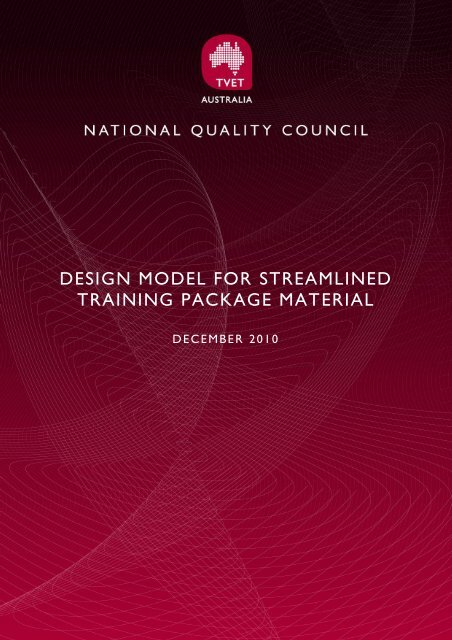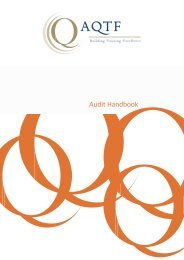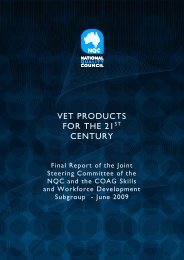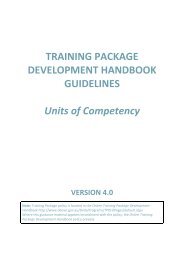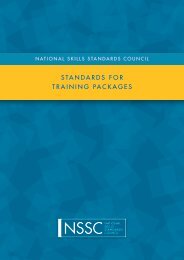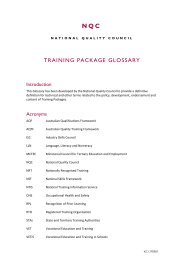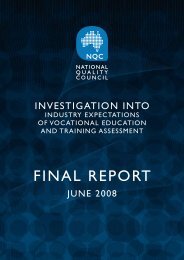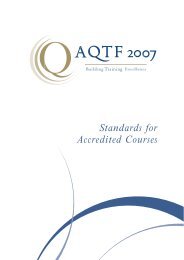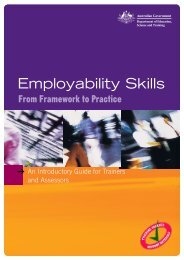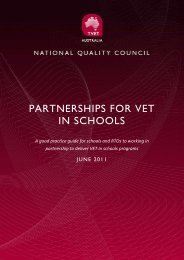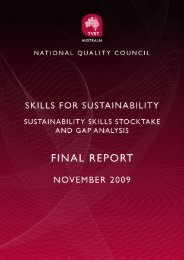Design model for Streamlined Training Package Report
Design model for Streamlined Training Package Report
Design model for Streamlined Training Package Report
- No tags were found...
Create successful ePaper yourself
Turn your PDF publications into a flip-book with our unique Google optimized e-Paper software.
DESIGN MODEL FOR STREAMLINEDTRAINING PACKAGE MATERIALD E CE M BER 2010
D E S I G N M O D E L F O R S T R E A M L I N E D T R A I N I N G P A C K A G E M A T E R I A LC O N T A C TNQC SecretariatTVET AustraliaLevel 21/390 St Kilda Road Melbourne Vic 3004Telephone: +61 3 9832 8100Email: nqc.secretariat@tvetaustralia.com.auWeb: www.nqc.tvetaustralia.com.auD I S C L A I M E RThis work has been produced on behalf of the National Quality Council with funding provided through theAustralian Government Department of Education, Employment and Workplace Relations and state andterritory governments. The views expressed herein are not necessarily those of the Australian Governmentor state and territory governments.A C K N O W L E D G E M E N TPrepared <strong>for</strong> the National Quality Council by Jana Scomazzon and Bernadette Delaney.©Commonwealth of Australia 2010This document is available under a “Preserve Integrity” licence.For details: http://www.aesharenet.com.au/P4All other rights reserved. For licensing enquiries contact licensing@tvetaustralia.com.auPage 2 of 28
D E S I G N M O D E L F O R S T R E A M L I N E D T R A I N I N G P A C K A G E M A T E R I A LC O N T E N T SForeword 3Contents 41. The <strong>Design</strong> Model 51.1 Users of the design <strong>model</strong> 51.2 Key characteristics of a streamlined design <strong>model</strong> 61.3 Diagram of the design <strong>model</strong> 72 Objectives and guidelines 82.1 Units of competency 82.1.1 Purpose and content 82.1.2 Objectives 82.1.3 Guidelines 92.2 Assessment requirements 102.2.1 Purpose and content 102.2.2 Objectives 102.2.3 Guidelines 122.3 Qualifications 142.3.1 Purpose and content 142.3.2 Objectives 142.3.3 Guidelines 152.4 Companion Volume 162.4.1 Purpose and content 162.4.2 Objectives 172.4.3 Guidelines 18Companion Volume: RTO Implementation Guide 18Companion Volume: Learning Strategies Guide 19Companion Volume: Knowledge Guide 20Companion Volume: Assessment Strategies Guide 21Appendices 22Appendix 1 - Acronyms 22Appendix 2 - Glossary of terms 23Appendix 3 - Suggested streamlined unit template 24Appendix 4 - Suggested streamlined qualification template 27Page 4 of 28
D E S I G N M O D E L F O R S T R E A M L I N E D T R A I N I N G P A C K A G E M A T E R I A L1.2 Key characteristics of a streamlined design <strong>model</strong>SimplifyPrevious NQC work highlighted stakeholder concern regarding the complexity of <strong>Training</strong> <strong>Package</strong>s. For thisreason a key characteristic of the proposed design <strong>model</strong> is that content is made more accessible bypresenting it in a simple, logical manner, using plain English.ShortenThe previous NQC work also highlighted stakeholder concern regarding the size of <strong>Training</strong> <strong>Package</strong>s. Thedesign <strong>model</strong> improves efficiency by reducing the level of detail and the amount of repetition in existingcontent, and by ensuring that <strong>Training</strong> <strong>Package</strong> components are functional and reflect the component’sintended purpose.SegmentStakeholders wanted <strong>Training</strong> <strong>Package</strong>s to be arranged in ways that are fit-<strong>for</strong>-purpose, and so the contentin the proposed design <strong>model</strong> has been organised to enhance its access, relevance and use. By separatingthe per<strong>for</strong>mance standards in a unit of competency from assessment requirements, and in a <strong>Training</strong><strong>Package</strong> from the guidance and supporting in<strong>for</strong>mation, the content in the proposed design <strong>model</strong> hasbeen organised to enhance its access, relevance and use.Simplifying the language of current <strong>Training</strong> <strong>Package</strong>s, shortening them by eliminating repetitive andunnecessary in<strong>for</strong>mation and reducing their level of detail, and at the same time segmenting them so thatthey align better to intended purpose, are seen as critical to ‘streamlining’ and the key characteristics of astreamlined design <strong>model</strong>.simplifysegmentshortenFigure 3: Key characteristics of streamlined design <strong>model</strong> <strong>for</strong> <strong>Training</strong> <strong>Package</strong>sAs may be seen in Figure 3 above, these three key characteristics intersect and complement each other.An explanation of the key characteristics is provided below to clarify intended meaning when these termsare referred to in the design <strong>model</strong>.Page 6 of 28
D E S I G N M O D E L F O R S T R E A M L I N E D T R A I N I N G P A C K A G E M A T E R I A L1.3 Diagram of the design <strong>model</strong>Figure 4: The <strong>Streamlined</strong> <strong>Design</strong> ModelPage 7 of 28
D E S I G N M O D E L F O R S T R E A M L I N E D T R A I N I N G P A C K A G E M A T E R I A L2 O B J E C T I V E S A N D G U I D E L I N E SThis section details the objectives <strong>for</strong> each component of the proposed design <strong>model</strong>. It then details theirassociated guidelines.Content <strong>for</strong> each component is included in the middle column of each component’s table.The objectives and guidelines detailed in the following pages are based on the design <strong>model</strong> in Section 1.The existing quality principles <strong>for</strong> <strong>Training</strong> <strong>Package</strong>s of flexibility, functionality, responsiveness andrecognition are there<strong>for</strong>e a given in the streamlined design <strong>model</strong>.2.1 Units of competency2.1.1 Purpose and contentThe main purpose of units of competency is to provide a statement of the skills and knowledge required <strong>for</strong>effective per<strong>for</strong>mance in a particular job or job function. They describe a work outcome and can logicallystand alone when applied in a work situation.The restructuring of the unit that has taken place within the context of streamlining has seen thein<strong>for</strong>mation previously found in the evidence guide relocated to assessment requirements; the integrationof the unit descriptor into the unit application section; and the development of clear guidelines around amore focused use of foundation skills. The <strong>for</strong>mer range statement is now to relate to context andoperating conditions only.To ensure that units are fit-<strong>for</strong>-purpose, they will need to be succinct and written in plain English. Much ofthe gain to be made through streamlining will be through removing repetitive and unnecessaryin<strong>for</strong>mation, reducing the level of detail, and simplifying language.2.1.2 ObjectivesThe objectives below underpin quality streamlined units of competency.Objective 1 Clarity and brevityUnits of competency describe the standards of per<strong>for</strong>mance required in the workplace in a clear, simpleand unambiguous manner, easily understood by users. They will be succinct but comprehensive.Objective 2 Suitability and relevanceThe central focus of a unit of competency is its per<strong>for</strong>mance standard, focusing on the per<strong>for</strong>manceexpected as an outcome and critical in<strong>for</strong>mation that in<strong>for</strong>ms that, and removing supporting advice andguidance in<strong>for</strong>mation.Objective 3 ConsistencyUnits of competency promote the consistent application of knowledge and skills by ensuring thatper<strong>for</strong>mance standards, requirements and conditions are explicit. They will use a consistent structure.Page 8 of 28
D E S I G N M O D E L F O R S T R E A M L I N E D T R A I N I N G P A C K A G E M A T E R I A L2.1.3 GuidelinesUnits of competencyPurpose Content GuidelinesProvideSpecification ofappliedper<strong>for</strong>mancestandardsUnit codeUnit titleApplicationPrerequisite unitsCompetency fieldUnit sectorElementsPer<strong>for</strong>mance criteriaFoundation skillsRange of conditionsLink to unit mappingin<strong>for</strong>mationSee Appendix 3 on page24 <strong>for</strong> suggested unittemplate. Instructionsaround the use of eachsection are included inthe template.1. Include a functional, concise and clearly-written description of thework task, and only necessary and specific in<strong>for</strong>mation. Criticallyanalyse content to ensure that the per<strong>for</strong>mance standard ispositioned as central to the outcome, and include only necessaryand specific in<strong>for</strong>mation.2. Do not contain generic content, or content that does not serve aclear and defining unit-specific purpose. Streamlining unitsinvolves eliminating the inclusion or repetition of unnecessary orgeneric phrases.3. Contain per<strong>for</strong>mance standards rather than guidance andsupporting in<strong>for</strong>mation and, where appropriate, includein<strong>for</strong>mation on foundation skills, sustainability, occupationalhealth and safety and licensing in<strong>for</strong>mation. Convey the essenceof the per<strong>for</strong>mance expected as an outcome, rather than astraining delivery advice.4. Ensure accessibility by eliminating ambiguity, using plain language,and avoiding the use of unnecessarily technical language andobscure syntax.5. Contain content that is presented in a logical, simple andconsistent manner, uni<strong>for</strong>mly structured and populated so thatin<strong>for</strong>mation is accessible and relevant to its intended purpose.6. Include a link to mapping in<strong>for</strong>mation where applicable, advisingof changes between the current version of each unit and itsprevious version and providing equivalence in<strong>for</strong>mation.Table 1: Guidelines and Content <strong>for</strong> units of competencyPage 9 of 28
D E S I G N M O D E L F O R S T R E A M L I N E D T R A I N I N G P A C K A G E M A T E R I A L2.2 Assessment requirements2.2.1 Purpose and contentThe assessment requirements are endorsed by the NQC and set out the industry’s approach to high qualityassessment.Assessment requirements 1 detail the assessment evidence that individuals must present to be judgedcompetent against a unit of competency. All mandatory requirements relevant to the <strong>Training</strong> <strong>Package</strong> willbe clearly and concisely written in the assessment requirements.The assessment requirements are designed so that assessment tools meet the principles of assessment:fairness, flexibility, reliability and validity.The evidence requirements will establish the conditions and context of assessment requirements. They willcomprise two evidence specifications <strong>for</strong> each unit of competency:• per<strong>for</strong>mance evidence• knowledge evidenceThe evidence must show that the candidate consistently meets all elements and per<strong>for</strong>mance criteria underthe conditions specified <strong>for</strong> the unit of competency. The evidence specifications <strong>for</strong> each unit ofcompetency are explained clearly in order to meet the rules of evidence; that is that evidence is valid,sufficient, authentic and current.2.2.2 Objectives<strong>Streamlined</strong> assessment requirements contain clear and concise advice on the necessary approaches toassessment.The objectives below underpin quality streamlined assessment requirements.Objective 1 ClarityAssessment requirements clearly indicate the context, conditions and benchmarks <strong>for</strong> assessment. Theyconsist of readily understood statements of the evidence of per<strong>for</strong>mance and knowledge required to judgecompetent per<strong>for</strong>mance.Objective 2 ConsistencyAssessment requirements provide sufficient details of the contextual requirements, including the scope andextent of conducting the assessment, as well as the sufficiency of evidence to ensure consistency of theassessment process. They document any special conditions relevant to the assessment environment or theassessment mode.1 Stowell, R. (2010) Preliminary Advice on the Assessment Requirements Component of a <strong>Streamlined</strong> <strong>Training</strong> <strong>Package</strong>paper to TVET. This paper served as the basis of the assessment requirements design.Page 10 of 28
D E S I G N M O D E L F O R S T R E A M L I N E D T R A I N I N G P A C K A G E M A T E R I A L2.2.3 GuidelinesAssessment RequirementsPurpose Content GuidelinesDescribe theassessmentrequirements atthe unit ofcompetency levelAssessment evidence 1. The assessment requirements will detail theassessment evidence that individuals must presentto be judged competent against a unit ofcompetency. The evidence prescribed will respondto the elements and per<strong>for</strong>mance criteria in theunit of competency.2. Assessment requirements will specify that evidencecomprises per<strong>for</strong>mance evidence and knowledgeevidence.• Per<strong>for</strong>mance evidence 3. The per<strong>for</strong>mance evidence will specify:• the required product and/or process evidence• the frequency and/or volume of product/processevidence• the relationship between the product andprocess evidence and the per<strong>for</strong>mance criteria.• Knowledge evidence 4. The knowledge evidence, in this context, is thein<strong>for</strong>mation an individual must possess to safelyand effectively per<strong>for</strong>m the work task described inthe unit of competency. This may includeknowledge of:• specific in<strong>for</strong>mation required to complete thework task i.e. <strong>for</strong>mula <strong>for</strong> pipe sizing• laws, regulations and codes of practice relevantto the work task i.e. electrical regulations• principles, processes and procedures that applyto the work task i.e. procedures <strong>for</strong> minimisinghazards in the workplace, ways of dealing withcontingencies, and principles that are applied tosolve specific problems.5. The knowledge evidence must relate directly to theper<strong>for</strong>mance criteria and/or range of conditions.6. The knowledge evidence must indicate the typeand depth of knowledge required relevant to thedemands of the unit of competency and AQF level.Page 12 of 28
D E S I G N M O D E L F O R S T R E A M L I N E D T R A I N I N G P A C K A G E M A T E R I A LAssessment RequirementsPurpose Content GuidelinesAssessment contextThe context in which theper<strong>for</strong>mance evidence must becollected i.e. in the workplace orunder simulated workplaceconditions.7. This section will clearly indicate if evidence ispermitted to be collected in a simulated workplaceor an existing workplace; a description of thefeatures of the environment must be provided inthe assessment conditions section.Assessment conditionsTerms under which assessment is totake place, including the environmentand timeframeUnits that must be co-assessedIntegrated and holistic assessmentAssessment requirements will:8. Specify the conditions under which assessment cantake place <strong>for</strong> both a simulated workplace and anexisting work environment, including detailedequipment and materials, contingencies,specifications, physical conditions, relationshipwith team members and supervisor, relationshipwith client/customer; and timeframe.9. Support the assessment of individual units ofcompetency. However integrated and holisticassessment is encouraged where it is logical togroup units together. To facilitate integratedassessment, units of competency within thequalification that may be clustered with the unitshould be identified.10. Stipulate any mandatory conditions <strong>for</strong> assessmentonline only, RPL, and distance or offshoreassessment.Table 2: Guidelines and Content <strong>for</strong> assessment requirementsPage 13 of 28
D E S I G N M O D E L F O R S T R E A M L I N E D T R A I N I N G P A C K A G E M A T E R I A L2.3 Qualifications2.3.1 Purpose and contentThrough the packaging of units of competency into meaningful groups aligned to the AustralianQualifications Framework, qualifications represent job roles.Key to the outcome of streamlining a qualification is a clear and concise statement advising requirementsand packaging rules. As such, changes were made to the <strong>for</strong>mat and structure of the packaging rules so thatthey were clear, concise and consistent.The aims below underpin quality streamlined qualifications. As advised above, the existing qualityprinciples of flexibility, functionality, responsiveness and recognition are a given in the streamlined design<strong>model</strong>, as are the NQC policy changes to ensure qualification flexibility.2.3.2 ObjectivesObjective 1 ConsistencyQualification requirements within and across industry areas are easy to understand, simple to identify andconsistent in approach to notes and rules.Objective 2 ResponsivenessQualifications respond to the needs of diverse users, both in terms of structure and content.Objective 3 AccessibilityQualifications clearly identify any relevant entry requirements and prerequisites <strong>for</strong> units of competency, aswell as entry and exit points. In<strong>for</strong>mation in qualifications is expressed in clear, plain language within afunctional structure.Objective 4 Clarity and brevityQualification requirements are structured in a clear, simple and unambiguous manner, to be easilyunderstood by users.Page 14 of 28
D E S I G N M O D E L F O R S T R E A M L I N E D T R A I N I N G P A C K A G E M A T E R I A L2.3.3 GuidelinesQualificationsPurpose Content GuidelinesDetail thequalificationscontained in the<strong>Training</strong> <strong>Package</strong>Qualification codeQualification titleQualification descriptionconsisting of:• entry requirements• licensing, legislative, regulatory orcertification considerationsPackaging rules:• total number of units ofcompetency required <strong>for</strong> thequalification• number of required core units• number of required elective unitsDetails of elective unit options,ensuring options that support NQCflexibility packing rules policy.Full list of core and elective unit codesand titles, including prerequisite unitswhere they apply.Link to qualification mappingin<strong>for</strong>mation1. Feature packaging rules that are structured tofacilitate the choice of a range of elective unitsresponsive to user’s current and future skill needs.2. Are functional, containing concise and clearlywrittendescriptions of job roles and including onlynecessary and specific in<strong>for</strong>mation.3. Are accessible with flexibility rules that allowindividual learners and employers to choose whichunits of competency are ‘packaged’ together tomeet the requirements <strong>for</strong> VET qualifications.4. Are clearly structured and consistently presented(refer the <strong>for</strong>matting in the suggested qualificationtemplate in Appendix 4 on page 27).5. Use clear and consistent packaging rules, with allunits of competency in the qualification packagingrules called either core or elective.6. Include only necessary and specific in<strong>for</strong>mation.,with no repetitive and unnecessary in<strong>for</strong>mation.7. Express qualification in<strong>for</strong>mation in clear, plainEnglish and provide clear ‘plain speaking’ packagingrules and pathways.8. Clearly identify the core and elective unit codes andtitles associated with the qualification, includingany prerequisite units in the packaging rules.9. Include a link to the Assessment Strategies Guide<strong>for</strong> suggested groupings of units of competencyrelevant to the industry sector, workplace and jobrole that could be holistically delivered andassessed.10. Include a link to qualification mapping in<strong>for</strong>mationwhere applicable, advising of changes between thecurrent version of each qualification and itsprevious version and providing equivalencein<strong>for</strong>mation.Table 3: Guidelines and Content <strong>for</strong> qualificationsPage 15 of 28
D E S I G N M O D E L F O R S T R E A M L I N E D T R A I N I N G P A C K A G E M A T E R I A L2.4 Companion VolumeThe companion volume to the <strong>Training</strong> <strong>Package</strong> will be a collection of separate guides that provide adviceto assist in the implementation of the <strong>Training</strong> <strong>Package</strong>. The in<strong>for</strong>mation in the guides may currently beavailable and in use, but is often inaccessible or in many different locations. Collecting specific in<strong>for</strong>mationinto one point of access will encourage uptake of the advice. More detailed in<strong>for</strong>mation will be available vialinks at the end of each guide.The companion volume will contain highly valuable advice and guidance, particularly <strong>for</strong> RTOs but also <strong>for</strong>STAs, regulatory bodies and AQTF auditors. However, the <strong>Training</strong> <strong>Package</strong> requirements that RTOs mustfollow will be contained in the endorsed <strong>Training</strong> <strong>Package</strong>.The audience <strong>for</strong> the companion volume will primarily be RTOs. STAs, VET regulators and other IndustrySkills Councils (ISCs) will be secondary audiences.Every <strong>Training</strong> <strong>Package</strong> will have an associated companion volume. A period of transition will be needed todevelop a companion volume <strong>for</strong> all existing <strong>Training</strong> <strong>Package</strong>s.Newly endorsed <strong>Training</strong> <strong>Package</strong>s will have a corresponding new companion volume publishedconcurrently. This volume will include in<strong>for</strong>mation that assists RTOs in implementation.ISCs are best placed to develop companion volumes. Input from other stakeholders – in particular RTOs,but also STAs and registering bodies - during the development process is seen as essential.Companion volumes will be reviewed and updated as part of the usual <strong>Training</strong> <strong>Package</strong> review cycle, butmay be subject to more frequent updating to ensure industry currency.In<strong>for</strong>mation in the companion volumes must be designed to suit the audience in terms of material requiredto assist implementation.While some standardisation of <strong>for</strong>m and structure will be required <strong>for</strong> companion volumes there will be amore flexible approach to the style and type of content contained in companion volumes to cater <strong>for</strong> thediversity of industries. Different industry’s advice and guidance may need to be represented in slightlydifferent ways.2.4.1 Purpose and contentRTO Implementation GuideThe main purpose of the RTO Implementation Guide is to in<strong>for</strong>m the RTO about the endorsed componentsof the <strong>Training</strong> <strong>Package</strong>. The content will consist of introductory advice about the structure of the <strong>Training</strong><strong>Package</strong> and related qualifications and units of competency. This companion volume will provide guidanceto the RTO on relevant issues in the industry and their impact on training needs and occupationaloutcomes.Input from STAs and registering bodies during development should help to shift in<strong>for</strong>mation that iscommon across all State and Territory implementation guides into the RTO implementation guide. Links toState and Territory implementation guides could be also be provided to ensure any specific localin<strong>for</strong>mation is easily accessible.Page 16 of 28
D E S I G N M O D E L F O R S T R E A M L I N E D T R A I N I N G P A C K A G E M A T E R I A LLearning Strategies GuideThe Learning Strategies Guide will address the importance of understanding the learning process andfacilitating choice <strong>for</strong> learners. It will explore learning in relation to training in the particular industry of therelated <strong>Training</strong> <strong>Package</strong>, and identify ways to select appropriate learning approaches suitable to thatindustry. By providing advice and case studies on contextualisation of units and qualifications, diverselearners will be catered <strong>for</strong> in different learning environments.Knowledge GuideThe importance of knowledge will be addressed in the Knowledge Guide. This will provide guidance on thebroad discipline knowledge as well as industry-specific knowledge pertinent to the <strong>Training</strong> <strong>Package</strong>.Knowledge applied in the workplace and the ability to transfer knowledge in new environments will beconsistent with the redefined notion of ‘competency’.Assessment Strategies GuideThe Assessment Strategies Guide will provide specific guidance on a range of assessment issues, includingassessment approaches and tools pertinent to the <strong>Training</strong> <strong>Package</strong> and advice on workplace contexts andsimulated environments. It will support and further explain the implementation issues of the endorsedassessment requirements of the <strong>Training</strong> <strong>Package</strong>.2.4.2 ObjectivesObjective 1 Relevant and appropriateCompanion volumes ensure close alignment to the endorsed components of the related <strong>Training</strong> <strong>Package</strong>,in particular ensuring that the definition of competency is consistent with the application of knowledge andskill to the standard of per<strong>for</strong>mance required in the workplace.Objective 2 Industry-focusedGuidance in the companion volumes will relate to implementation of the <strong>Training</strong> <strong>Package</strong> being directlyrelevant to the needs of the particular industry by providing industry-specific examples and issues tofurther in<strong>for</strong>m the RTO.Objective 3 Accessible and flexibleCompanion volume material will be easy to read, with a logical structure set out in discrete sections .Thepresentation requirements will provide flexibility to cater <strong>for</strong> the needs of different industries and a varietyof learners.Objective 4 QualityCompanion volumes will have a quality assurance process based on their own set of separate establishedprinciples.Page 17 of 28
D E S I G N M O D E L F O R S T R E A M L I N E D T R A I N I N G P A C K A G E M A T E R I A L2.4.3 GuidelinesCompanion Volume: RTO Implementation GuidePurpose Content GuidelinesProvide in<strong>for</strong>mationto assist RTOs ininterpreting andunderstanding theendorsedcomponents of the<strong>Training</strong> <strong>Package</strong>Overview in<strong>for</strong>mation• Version control and modification history• List of AQF qualifications, skill sets andunits of competency in the <strong>Training</strong><strong>Package</strong>• Employability skills tables and advice linkedto qualifications• List of imported and prerequisite units inthe <strong>Training</strong> <strong>Package</strong>• Key industry issues and work and trainingrequirements in the industry• In<strong>for</strong>mation on entry requirements• Regulation and licensing implementationissuesImplementation in<strong>for</strong>mation• In<strong>for</strong>mation on the key features of the<strong>Training</strong> <strong>Package</strong> and the industry that willimpact on the selection of trainingpathways• Explanation of the qualifications and thevarious industry sectors• Detail on qualifications and occupationaloutcomes in the industry• Advice on any OHS implications in theindustry• Resource and equipment lists relevant tothe <strong>Training</strong> <strong>Package</strong>s• Legal considerations <strong>for</strong> learners in theworkplace/on placementsLinks• Industry profile• Skill demands in the industry• General in<strong>for</strong>mation on understandingper<strong>for</strong>mance standards in the VET sector• General in<strong>for</strong>mation on VET training andassessment approaches1. Provide clear in<strong>for</strong>mation on the <strong>Training</strong><strong>Package</strong> endorsed components.2. Present in<strong>for</strong>mation about the <strong>Training</strong><strong>Package</strong>, with current industry examplesand issues relevant to training andassessment.3. Organise and present <strong>Training</strong> <strong>Package</strong>in<strong>for</strong>mation relevant to RTOimplementation plans.4. Present in<strong>for</strong>mation about the <strong>Training</strong><strong>Package</strong>, with current industry examplesand issues relevant to training andassessment.5. Plan qualifications and pathways in thecontext of industry requirements.6. Identify examples of current industryapproaches to training.7. Provide links to relevant material.Table 4: Guidelines and Content RTO Implementation GuidePage 18 of 28
D E S I G N M O D E L F O R S T R E A M L I N E D T R A I N I N G P A C K A G E M A T E R I A LCompanion Volume: Learning Strategies GuidePurpose Content GuidelinesIntroduce anddescribe diversityof learners andlearningstrategiesLearning approaches• Learning principles (e.g. adult learning)• Learning theories and processes• Learning styles and diverse learning needs• Applied learning strategies• Learner-directed learning• Learner support• Customised training deliveryLearning environment• Establishing and meeting learner needs• Supporting the <strong>Training</strong> <strong>Package</strong>: online,work-based, distance, assessment only• Setting up the simulated environment offand on the job• Work-based learning structures• Selecting work placements• Suitable equipment and machinery in theworkplace and their availability <strong>for</strong> trainingand assessment activitiesContextualisation• Explanation of contextualisation of units ofcompetency, qualifications and skill sets byRTOs• Examples of contextualisation and issues indifferent settings (e.g. enterprise, regionaland offshore)Learner outcomes• Guidance in<strong>for</strong>mation to learners• Qualification pathways chart• Pathways to further education or workLinks• Learning resources• Resources on VET training and learning1. Provide guidance on dynamic learningapproaches to meet the diversity of learnerneeds that is customised, contextualisedand specific to the <strong>Training</strong> <strong>Package</strong> andthe industry.2. Provide strategies on learner needs thatspecifically suit the industry and trainingcontexts.3. Provide guidance on learning strategiesrelevant to the <strong>Training</strong> <strong>Package</strong> units ofcompetency and qualifications.4. Provide guidance relevant to the <strong>Training</strong><strong>Package</strong> on the requirements of delivery indifferent context with diverse learners.5. Provide guidance on how to contextualisein the particular industry.6. Provide examples of contextualisation ofvarious qualifications and skills sets.7. Provide advice on potential pathways <strong>for</strong>various learners and employmentoutcomes in the context of qualificationsand skill sets.8. Provide Links to relevant in<strong>for</strong>mation.Table 5: Guidelines and Content Learning Strategies guidePage 19 of 28
D E S I G N M O D E L F O R S T R E A M L I N E D T R A I N I N G P A C K A G E M A T E R I A LCompanion Volume: Knowledge GuidePurpose Content GuidelinesIdentify contextualin<strong>for</strong>mation,including knowledgerequirements andresourcesBroad discipline in<strong>for</strong>mation• Occupation and field specific in<strong>for</strong>mation• Theoretical knowledge underpinningcompetency1. Provide guidance on the knowledge base<strong>for</strong> the various occupations covered in the<strong>Training</strong> <strong>Package</strong>.2. Advise on the application of knowledge inthe workplace, as reflected in theendorsed components.Industry-specific in<strong>for</strong>mation• Industry and sector-specific in<strong>for</strong>mation• Qualification-specific industry in<strong>for</strong>mation3. Provide succinct industry knowledge toin<strong>for</strong>m implementation.4. Provide guidance on the importance ofknowledge <strong>for</strong> all individuals in theworkplace.Applied knowledge• Application of knowledge in the workplace• Assistance in developing underpinningknowledge through learning experiences• Embedding knowledge required to developcompetency in the learning programs• Assistance in identifying opportunities todemonstrate knowledge in new situationsand environmentsLinks• Resources to support knowledgeacquisition• Current issues in the industry5. Provide guidance on the importance ofknowledge to the achievement ofcompetence.6. Determine the knowledge that is criticalto the development of competency.7. Provide guidance on knowledge andcontext.8. Provide Links to relevant in<strong>for</strong>mationTable 6: Guidelines and Content Knowledge GuidePage 20 of 28
D E S I G N M O D E L F O R S T R E A M L I N E D T R A I N I N G P A C K A G E M A T E R I A LCompanion Volume: Assessment Strategies GuidePurpose Content GuidelinesProvide guidance onimplementation ofassessmentrequirements in theendorsedcomponents of a<strong>Training</strong> <strong>Package</strong>Assessment and the <strong>Training</strong> <strong>Package</strong>• Assessment advice <strong>for</strong> imported units ofcompetency• Advice on assessment <strong>for</strong> licensingpurposes• Reasonable adjustmentAssessment methods• Assessment tools fit <strong>for</strong> purpose• Assessment only/RPLAssessment conditions• Assessment context requirements• Assessment in the workplace• Assessment simulation guidance• Assessor requirements <strong>for</strong> specificqualifications• Assessment and partnership arrangements• Assessment only pathways• Any suggested assessor requirements(additional to NQC assessor requirements).Evidence advice• Benchmarks• Importance of demonstrating skills andknowledge in the industry• Evidence collection• Holistic assessment and the collection ofevidenceAssessment validation• Refining and reviewing assessment tools• Validating assessment tools and evidenceLinks• Assessment tools• NQC publications1. Provide general guidance on assessmentrelevant to the <strong>Training</strong> <strong>Package</strong>.2. Provide guidance on the knowledge andskills required to achieve competence.3. Provide further guidance on assessmentpathways and approaches.4. Provide guidance on conditions <strong>for</strong>assessment.5. Identify other units of competency withinthe qualification that may be clusteredwith the unit <strong>for</strong> assessment and deliverypurposes.6. Provide guidelines on the assessmentrequirements in the industry.7. Provide guidelines on the assessmentrequirements of the <strong>Training</strong> <strong>Package</strong>.8. Provide guidelines on assessmentvalidation and industry expectations ofassessment.9. Provide links to relevant in<strong>for</strong>mation.Table 7: Guidelines and Content Assessment Strategies guidePage 21 of 28
D E S I G N M O D E L F O R S T R E A M L I N E D T R A I N I N G P A C K A G E M A T E R I A LA P P E N D I C ESAppendix 1 - AcronymsAcronymAQFAQTFISCLLNNQCNTISRPLRTOSTATPDHVETTermAustralian Qualifications FrameworkAustralian Quality <strong>Training</strong> FrameworkIndustry Skills Councillanguage, literacy and numeracyNational Quality CouncilNational <strong>Training</strong> In<strong>for</strong>mation Servicerecognition of prior learningregistered training organisationState <strong>Training</strong> Authority<strong>Training</strong> <strong>Package</strong> Development HandbookVocational Education and <strong>Training</strong>Page 22 of 28
D E S I G N M O D E L F O R S T R E A M L I N E D T R A I N I N G P A C K A G E M A T E R I A LAppendix 2 - Glossary of termsTermAssessmentAssessmentrequirementsCompetencyObjectives ofdesign <strong>model</strong><strong>Design</strong> <strong>model</strong>Foundation skillsGuidelines ofdesign <strong>model</strong>QualificationStreamlining<strong>Training</strong> <strong>Package</strong>Unit ofcompetencyDefinitionThe process of collecting evidence and making judgements on whether competency has beenachieved, in order to confirm that an individual can per<strong>for</strong>m to the standard expected in theworkplace, as expressed by the relevant endorsed industry/enterprise competency standards of a<strong>Training</strong> <strong>Package</strong> or by the learning outcomes of an accredited course.An endorsed component of a streamlined <strong>Training</strong> <strong>Package</strong>, assessment requirements set out theindustry’s approach to valid, reliable, flexible and fair assessment.Defined as the consistent application of knowledge and skill to the standard of per<strong>for</strong>mancerequired in the workplace. It embodies the ability to transfer and apply skills and knowledge tonew situations and environments.Characteristics of the design <strong>model</strong>.A conceptual perspective of a series of interconnecting components, which together represent astreamlined <strong>Training</strong> <strong>Package</strong> and its companion volumeEncompass the language, literacy and numeracy skills, or core skills, of reading, writing, oralcommunication, numeracy and learning described by the Australian Core Skills Framework, as wellas employability skills.Advice on the implementation of the objectives of the design <strong>model</strong>.Created by combining units of competency into meaningful groups aligned to the AustralianQualifications Framework and endorsed by the National Quality Council within the <strong>Training</strong><strong>Package</strong> Qualifications Framework.Defined as <strong>for</strong>mal certification, issued by a relevant approved body, in recognition that a personhas achieved learning outcomes or competencies relevant to identified individual, professional,industry or community needs.Simplifying, condensing and restructuring material to make it more functional and fit <strong>for</strong> purpose.Current research defines a <strong>Training</strong> <strong>Package</strong> as an integrated set of nationally endorsedcompetency standards, assessment guidelines and Australian Qualifications Frameworkqualifications <strong>for</strong> a specific industry, industry sector or enterprise.Each <strong>Training</strong> <strong>Package</strong>:• provides a consistent and reliable set of components <strong>for</strong> training, recognising and assessingpeoples skills, and may also have optional support materials• enables nationally recognised qualifications to be awarded through direct assessment ofworkplace competencies• encourages the development and delivery of flexible training which suits individual andindustry requirements• encourages learning and assessment in a work-related environment which leads to verifiableworkplace outcomes.A nationally agreed statement of the skills and knowledge required <strong>for</strong> effective per<strong>for</strong>mance in aparticular job or job function; describes a work outcome; can logically stand alone when applied ina work situation.See also competency above.Page 23 of 28
D E S I G N M O D E L F O R S T R E A M L I N E D T R A I N I N G P A C K A G E M A T E R I A LAppendix 3 - Suggested streamlined unit templateThe proposed structure and instructions on content of the components that make up the units ofcompetency are detailed in the sample template below. Instructions and comments about the use of thetemplate are included.UNIT CODEMandatory fieldUNIT TITLEMandatory fieldTitles must concisely describe the unit outcome and not exceed 100 characters(including spaces).Unit titles are often unnecessarily long and sometimes include justificationstatements (e.g. ‘to ensure safe operation’), which is not in line with <strong>Training</strong><strong>Package</strong> Development Handbook (TPDH) policy.Note: In<strong>for</strong>mation in the TPDH to remain, with added guidance by way of examplesregarding specificity of industry or sector (where unit content itself does not detailgeneric application).APPLICATIONMandatory fieldThe application section briefly describes how the unit is practically applied in theindustry and in what context the unit may be applied. The section is useful <strong>for</strong> jobdescriptions, recruitment advice and job analysis.Includes:• brief description of unit content, but avoids doing no more than embedding theunit title in a sentence. This section is an opportunity to provide a usefulsummary statement of unit content;• focused, useful in<strong>for</strong>mation on how and where the unit of competency could bepractically applied and who might use it; and• unit of competency’s relationship to licensing, legislative, regulatory orcertification requirements, where they exist.Note: In<strong>for</strong>mation in TPDH to remain, with added guidance to ensure that thepurpose of the application section is understood and examples are provided so thatsection is better understood and it provides meaningful summary statement of unitto in<strong>for</strong>m users.PREREQUISITE UNITOptional fieldLists any unit in which the candidate must be deemed competent prior to thedetermination of competency in the unit.Prerequisite units of competency must only be used where they are critical toachieving the subsequent unit. There is growing awareness among <strong>Training</strong><strong>Package</strong> developers of the need to minimise the use of prerequisite units wherepossible.Note: In<strong>for</strong>mation in TPDH to remain, with added guidance as to the criteria to beused to determine if the prerequisite is critical to achieving the subsequent unit.COMPETENCY FIELDOptional fieldField allows retrieval of in<strong>for</strong>mation in companion volume common to a group ofunits. Include where the grouping of unit in<strong>for</strong>mation is applicable.Note: this field is currently not supported by NTIS.UNIT SECTOROptional fieldField allows units to be displayed on search engine in sector groups. Include whereapplicable.Page 24 of 28
D E S I G N M O D E L F O R S T R E A M L I N E D T R A I N I N G P A C K A G E M A T E R I A LELEMENTSMandatory fieldElements describe the essentialoutcomes.1. Elements must describeactions or outcomes thatare demonstrable andassessable.PERFORMANCE CRITERIAMandatory fieldPer<strong>for</strong>mance criteria describe the per<strong>for</strong>mance needed to demonstrateachievement of the element. Where bold italicised text is used, further in<strong>for</strong>mationis detailed in the range of conditions section.1.1 Per<strong>for</strong>mance criteria must clearly relate to the element.1.2 They must be expressed as a standard.1.3 They must specify the required per<strong>for</strong>mance in relevant tasks, roles, and skills.1.4 They must reflect the applied knowledge that enables competentper<strong>for</strong>mance.1.5 Active voice is encouraged.FOUNDATION SKILLSMandatory fieldThis section describes those required skills (language, literacy and numeracy) that are essential to per<strong>for</strong>mance.• foundation skills (employability and language, literacy and numeracy skills) are the principal focus of this sectionand so where there are significant foundation skill demands evident in the per<strong>for</strong>mance criteria, refer to themexplicitly in this section• the foundation skills must have a strong association with the specifics of the unit• section does not include:• technical skills implicit in the per<strong>for</strong>mance criteria• broad generalised statements• generic repeated items that resemble a list of ALL skills, rather than the foundation skills deemed essential tocompetent per<strong>for</strong>manceRANGE OF CONDITIONSOptional fieldThis field allows <strong>for</strong> different work environments and conditions that may affect per<strong>for</strong>mance. Essential operatingconditions that may be present with training and assessment (depending on the work situation, needs of thecandidate, accessibility of the item, and local industry and regional contexts) should be included. Bold italicisedwording, if used in the per<strong>for</strong>mance criteria, is detailed below.Range must be:• restricted to essential operating conditions and any other variables essential tothe work environment• kept to a minimum, and indeed kept blank if not required (this section is anoptional field)Page 25 of 28
D E S I G N M O D E L F O R S T R E A M L I N E D T R A I N I N G P A C K A G E M A T E R I A LELEMENTSMandatory fieldRange must:Unit Mapping In<strong>for</strong>mationPERFORMANCE CRITERIAMandatory field• NOT repeat entire rows of variables from unit to unit, with similar lists that arenot necessarily specific to the unit of competency• NOT be a glossary of terms• NOT provide explanatory detail more suited to notes a trainer would develop inplanning course delivery• NOT include generic advice or in<strong>for</strong>mation, which is better suited to acompanion volume• NOT be used in place of in<strong>for</strong>mation in the unit’s application section orassessment requirements component (e.g. ‘must include’ variables).• Provide link to unit mapping in<strong>for</strong>mationPage 26 of 28
D E S I G N M O D E L F O R S T R E A M L I N E D T R A I N I N G P A C K A G E M A T E R I A LAppendix 4 - Suggested streamlined qualification templateQualifications and the qualification structure must comply with the TPDH.The in<strong>for</strong>mation in the template below is considered mandatory.QUAL CODEQUALIFICATION TITLEQualification descriptionConsisting of 1• mandatory and clearly justified entry requirements, which are to be included where they are relevant• licensing, legislative, regulatory or certification considerations.Packaging rules 2Total number of units of competency =• xx core unit codes and titles• xx elective unit codes and titlesDetails of elective unit options, ensuring that electives may also be chosen from elsewhere in the <strong>Training</strong> <strong>Package</strong>,other <strong>Training</strong> <strong>Package</strong>s or state accredited courses, provided the integrity of the AQF alignment is ensured, and theycontribute to a valid, industry-supported vocational outcome.Full list of core and elective unit codes and titles, including prerequisite units where they apply.The following text could be includedRefer to the Assessment Strategies Guide in the Companion Volume <strong>for</strong> further advice on the grouping of units toreflect various job tasks and current workplaces relevant to the specified job role1 Pathways in<strong>for</strong>mationAs pathway in<strong>for</strong>mation is often generic, repeated from like qualification to another, it has been removedfrom the qualification template and relocated to the companion volume component.Further optional in<strong>for</strong>mation that may be included in the qualification description includes:• audience statement and occupational titles• outcome statement, which could relate to preparation <strong>for</strong> or an actual job outcome2 Packaging rulesThe packaging rules must comply with the <strong>Training</strong> <strong>Package</strong> Development Handbook. They must providein<strong>for</strong>mation on the elective unit options in clear and succinct language and <strong>for</strong>mat.Page 27 of 28
D E S I G N M O D E L F O R S T R E A M L I N E D T R A I N I N G P A C K A G E M A T E R I A LPage 28 of 28


